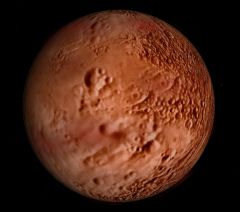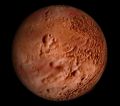Difference between revisions of "Amalthea"
Jump to navigation
Jump to search
(Created page with "Amalthea is an inner irregular satellite of jupiter, measuring 250 km across and is noted for it's red color.") |
(Added category.) |
||
| (9 intermediate revisions by 4 users not shown) | |||
| Line 1: | Line 1: | ||
| − | Amalthea is an inner irregular | + | {{Nsat-Stub}} |
| + | |||
| + | {| cellpadding="2" cellspacing="0" style="margin:25px 0 0 10px; border:3px solid lightsteelblue;width:250px; font-size:90%; font-family:'Arial','Helvetica'; float: right; clear: right;"Template in Orbiter" | ||
| + | !bgcolor="lightsteelblue" colspan="2" align="center" |Amalthea | ||
| + | |- | ||
| + | |colspan="2" align="center"|[[Image:Amalthea-jupiterizip.jpg|240px]] | ||
| + | |- | ||
| + | |colspan="2" align="center"|'''Amalthea from jupiter_i.zip in Orbiter 2002''' | ||
| + | |- | ||
| + | !bgcolor="lightsteelblue" colspan="2"|Designation | ||
| + | |- | ||
| + | |Name||align="right"|Amalthea | ||
| + | |- | ||
| + | |width="30%"|Reference body||align="right" width="30%"|[[Jupiter]] | ||
| + | |- | ||
| + | !bgcolor="lightsteelblue" colspan="2"|Planetary mean orbits | ||
| + | |- | ||
| + | |width="30%"|Epoch||align="right" width="50%"|1976.606435 | ||
| + | |- | ||
| + | |width="30%"|Semimajor axis (a)||align="right" width="50%"|181300000 m | ||
| + | |- | ||
| + | |width="30%"|Eccentricity (e)||align="right" width="30%"|0.0003 | ||
| + | |- | ||
| + | |width="30%"|Inclination (i)||align="right" width="30%"|0.4° <br> (0.0069813 radian) | ||
| + | |- | ||
| + | |width="30%"|Longitude of the ascending node (LAN, ☊)||align="right" width="30%"|112.3003008° <br> (1.96001 radian) | ||
| + | |- | ||
| + | |width="30%"|Longitude of periapsis (ϖ)||align="right" width="30%"|60.00014031° <br> (1.0472 radian) | ||
| + | |- | ||
| + | |width="30%"|Mean longitude (L)||align="right" width="30%"|36.90421158° <br> (0.6441 radian) | ||
| + | |- | ||
| + | !bgcolor="lightsteelblue" colspan="2"|Selected physical parameters | ||
| + | |- | ||
| + | |width="30%"|Mean radius||align="right" width="30%"|101000 m | ||
| + | |- | ||
| + | |width="30%"|Mass||align="right" width="30%"|7.17×10<sup>18</sup> kg | ||
| + | |- | ||
| + | !bgcolor="lightsteelblue" colspan="2"|Rotation elements | ||
| + | |- | ||
| + | |width="30%"|SidRotPeriod||align="right" width="30%"|43042.7 seconds (11.9563 hours) | ||
| + | |- | ||
| + | |width="30%"|SidRotOffset||align="right" width="30%"|0 | ||
| + | |- | ||
| + | |width="30%"|Obliqutiy||align="right" width="30%"|0 | ||
| + | |- | ||
| + | |width="30%"|LAN||align="right" width="30%"|0 | ||
| + | |- | ||
| + | |width="30%"|Note||align="right" width="30%"|*Elements given are from Amalthea.cfg (jupiter_i.zip) | ||
| + | |} | ||
| + | |||
| + | |||
| + | '''Amalthea (Jupiter V)''' is an inner irregular [[natural satellites|moon]] of [[Jupiter]], measuring 250 km across and is noted for its red color. Amalthea was discovered by [[w:Edward Emerson Barnard|E E Bernard]] on 9 September 1892, named after a nymph in Greek mythology. This was the last moon to be discovered by direct observation. All others after were discovered photographically or digital imaging. | ||
| + | |||
| + | == Amalthea in Orbiter == | ||
| + | Amalthea was introduced to [[Orbiter]] with the add-on ''jupiter_i.zip'' released in October 2002. | ||
| + | |||
| + | {|class="wikitable sortable” style="text-align: center" | ||
| + | |colspan="8"|<center>'''Orbiter versions and add-ons which include Amalthea'''</center> | ||
| + | |- | ||
| + | !Add-on!!Source!!Version!!Author!!Type!!Release Date!!Compatibility!!Wiki article | ||
| + | |- | ||
| + | |[https://library.avsim.net/esearch.php?DLID=&Name=&FileName=jupiter_i.zip&Author=&CatID=root Jupiter I]||AVSIM||||Rolf Keibel||Scenery||25 October 2002|||| | ||
| + | |} | ||
| + | |||
| + | == See also == | ||
| + | [[w:Amalthea (moon)|Amalthea]] at [[w:Wikipedia|Wikipedia]] | ||
| + | |||
| + | == Gallery == | ||
| + | <gallery> | ||
| + | Amalthea-jupiterizip.jpg|<center>Amalthea from ''jupiter_i.zip'' in Orbiter 2002</center> | ||
| + | Amalthea (moon).png|<center>Amalthea as seen by [[w:|Voyager 1|Voyager 1]] on 5 March 1979,<br>from Wikimedia Commons</center> | ||
| + | </gallery> | ||
| + | |||
| + | {{JupiterSat}} | ||
| + | {{SolarSystem}} | ||
| + | |||
| + | [[Category: Articles]] | ||
| + | [[Category: Celestial bodies]] | ||
| + | [[Category:Solar System]] | ||
| + | [[Category: Natural satellites]] | ||
| + | [[Category: Satellites of Jupiter]] | ||
Latest revision as of 03:17, 12 September 2024
 | This natural satellite related article is a stub. You can help Orbiterwiki by expanding it.
Amalthea in Orbiter[edit]Amalthea was introduced to Orbiter with the add-on jupiter_i.zip released in October 2002.
See also[edit]Gallery[edit]
| ||||||||||||||||||||||||||||||||||||||||||||||||||||||||||||||||||||||||||||||||


